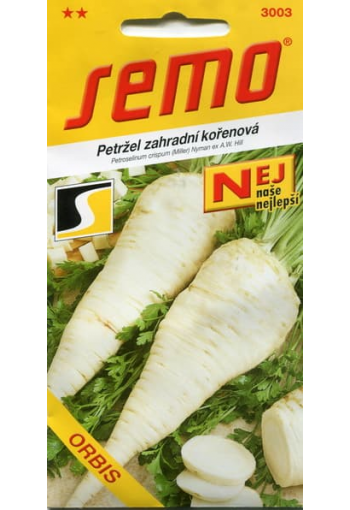Ex Tax: 1.14€
Delicious and fragrant!
Early maturing variety of high-yielding root parsley.
The period from germination to ripening of root crops is 77-84 days. Root crops are conical, spiky, with white pulp, average length 25 cm, weight 60 g.
They are characterized by a high content of vitamins and dry substances, excellent taste. For fresh use and canning.
Growing conditions.
At a temperature of + 3 + 4 ° C shoots appear in 15-20 days. The culture is light and moisture-loving, but does not tolerate waterlogging. Placed on loose, fertile soils.
Seeding scheme: 20 x 10 cm.
Sowing: IV.
Harvest: IX-X.
Parsley is grown as a green and spicy-aromatic crop. Its leaves and roots contain essential oils, mineral salts of potassium, calcium, phosphorus, iron, vitamins A, C, B4, B2, PP, K.
Germination: 15 20 days.
Seeds: in 1 g - 450-650 pcs.
Sowing: leafy varieties are sown in spring - in mid-April - early May; in summer - until the first decade of July (later sowing is possible - until the second decade of August, but then it is necessary to soak the seeds for 24 hours in water or solutions of physiologically active substances, such as: Epin; Potassium humate (0.1% solution), before winter - in late October Root varieties are sown in late April-early May.
Seeding rate: 0.5-1.0 g/m2.
Sowing depth: 1-2 cm on heavy loam, 2.0-2.5 cm on sandy loam. Sowing in the ordinary way with row spacing of 30-40 cm. Thickened crops with row spacing of 10-12 cm are also carried out; in this case, when the plants reach 15 cm in height, they are removed for greenery, pulling out after 1 row.
Soil: loose, well-aerated, humus-rich sandy or loamy soils, with a deep arable horizon. Root parsley is best placed in the 2nd year after manure is applied, otherwise the root crops branch (leaf parsley can also be grown on fresh manure).
The best predecessors: cucumber, tomato, onion, early white cabbage, table beet, tomato, cauliflower and potatoes.
Immediately after harvesting the predecessor, plant residues are crushed in the fall, and after 7-10 days the site is dug up to a depth of 20-25 cm. If parsley is grown for greens, then manure, humus or compost can be applied for plowing. In the spring, harrowing is carried out and, if necessary, ridges are made. It is necessary to apply mineral fertilizers: for root varieties - ammonium nitrate (10-20 g/m2), potassium salt (15-20 g/m2), superphosphate (20-25 g/m2); under leaf varieties - nitrogen (up to 30 g / m2), potash (10 g / m2) and phosphorus (up to 15 g / m2) fertilizers, furnace ash (120-150 g / m2) can be added.
The first thinning is in the phase of 2-3 true leaves. The second - in 15-20 days. For leaf parsley, plants in a row are thinned out, leaving 3-4 cm between them, for root parsley - 5-6 cm. Removed plants can be used for food.
Crop care includes weeding, loosening row spacing and top dressing. The first top dressing is carried out after the first thinning: ammonium nitrate (10-20 g / m2), potassium salt (10-15 g / m2) and superphosphate (15-20 g / m2) or complex fertilizers are introduced, preferably in dissolved form (solution, azophoska), at the rate of 30-40 g / m2 per 10 liters of water. After that, 2 more feedings are carried out with an interval of 2 weeks.
Harvesting: leaf parsley is cut for the first time 2 months after germination. The second cut is carried out in August, the third - in the fall. You can selectively cut parsley leaves as they grow back.
In autumn, plants are fed with a solution of complex mineral fertilizers (40-50 g per 10 liters of water). Plants can be left in the soil until spring for fresh greens.
Root parsley is harvested in late September - early October (before the onset of stable frosts). The dug roots are cleaned from the ground, the old leaves are cut off, leaving petioles 1.0-1.5 cm long. Healthy large root crops are selected for storage.
Eng.: Root parsley. Suom.: Juurpersilja. Sven.: Rotpersilja, slätbladig persilja. Bot. syn.: Apium petroselinum L., Carum petroselinum Benth., Petroselinum hortense auct., Petroselinum sativum Hoffm., Petroselinum tuberosum, Petroselinum vulgare.











